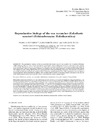Identificador persistente para citar o vincular este elemento:
https://accedacris.ulpgc.es/handle/10553/9124
| Campo DC | Valor | idioma |
|---|---|---|
| dc.contributor.author | González Navarro, Pablo | en_US |
| dc.contributor.author | García Sanz, Sara | en_US |
| dc.contributor.author | Tuya, F. | en_US |
| dc.date.accessioned | 2012-12-14T05:00:22Z | - |
| dc.date.accessioned | 2018-03-15T14:29:59Z | - |
| dc.date.available | 2012-12-14T05:00:22Z | - |
| dc.date.available | 2018-03-15T14:29:59Z | - |
| dc.date.issued | 2012 | en_US |
| dc.identifier.issn | 0214-8358 | en_US |
| dc.identifier.other | WoS | - |
| dc.identifier.uri | https://accedacris.ulpgc.es/handle/10553/9124 | - |
| dc.description.abstract | The reproductive biology of the sea cucumber Holothuria sanctori was studied over 24 months (February\n2009 to January 2011) at Gran Canaria through the gonad index and a combination of macro- and microscopic analysis\nof the gonads. Holothuria sanctori showed a 1:1 sex ratio and a seasonal reproductive cycle with a summer spawning: the\nmean gonad index showed a maximum (3.99±0.02) in summer (June-July) and a minimum (0.05±0.04) between late autumn\n(November) and early spring (March). Females had significantly wider gonad tubules than males. First maturity occurred at a size of 201 to 210 mm, a gutted body weight of 101 to 110 g and a total weight of 176 to 200 g. Holothuria sanctori shows a typical temperate species reproduction pattern. These results could be useful for managing current extractions of H. sanctori in the Mediterranean and in case a specific fishery is started in the eastern Atlantic region. | en_US |
| dc.description.abstract | Se estudió la biología reproductiva del pepino de mar Holothuria sanctori durante 24 meses (Febrero de 2009 a Enero de 2010) en la isla de Gran Canaria, mediante el índice gonadal y una combinación de análisis macro y microscópicos de sus gónadas. Holothuria sanctori presentó una relación de sexos de 1:1 y un solo ciclo reproductivo anual con desove en los meses estivales: el índice gonadal medio presentó un máximo (3.99±0.02) en verano (Junio-Julio) y un mínimo (0.05±0.04) entre finales de otoño (Noviembre) y primeros de primavera (Marzo). Las hembras presentaron túbulos gonadales significativamente más anchos que los de los machos. La primera madurez tuvo lugar con una talla de 201-210 mm, un peso eviscerado de 101-110 g y un peso total de 176-200 g. Holothuria sanctori presenta un patrón de reproducción típico en especies de zonas templadas. Estos resultados pueden ser útiles para gestionar las capturas actuales de H. sanctori en el Mediterráneo y en el caso de que una pesquería específica empezase en la región oriental del Atlántico. | en_US |
| dc.format | application/pdf | - |
| dc.language | eng | en_US |
| dc.relation.ispartof | Scientia Marina | en_US |
| dc.rights | by-nc-nd | - |
| dc.source | Scientia Marina [ISSN 0214-8358], v. 76 (4), p. 741-752, (Diciembre 2012) | en_US |
| dc.subject | 241705 Biología marina | en_US |
| dc.subject.other | Western Indian-Ocean | - |
| dc.subject.other | Metamorphosis | - |
| dc.subject.other | Gametogenesis | - |
| dc.subject.other | Temperature | - |
| dc.subject.other | Holothuria Sanctori | - |
| dc.subject.other | Sea Cucumber | - |
| dc.subject.other | Holothurians | - |
| dc.subject.other | Reproduction | - |
| dc.subject.other | Life-Cycle | - |
| dc.subject.other | Maturity | - |
| dc.subject.other | Canary Islands | - |
| dc.title | Reproductive biology of the sea cucumber Holothuria sanctori (Echinodermata: Holothuroidea) | en_US |
| dc.title.alternative | Biología reproductiva del pepino de mar Holothuria sanctori (Echinodermata: Holothuroidea) | en_US |
| dc.type | info:eu-repo/semantics/article | en_US |
| dc.type | Article | en_US |
| dc.identifier.doi | 10.3989/scimar.03543.15B | en_US |
| dc.identifier.scopus | 84871628084 | - |
| dc.identifier.isi | 000312387800013 | - |
| dc.contributor.authorscopusid | 8639201700 | - |
| dc.contributor.authorscopusid | 55334747600 | - |
| dc.contributor.authorscopusid | 6603608107 | - |
| dc.identifier.absysnet | 672465 | - |
| dc.identifier.eissn | 1886-8134 | - |
| dc.description.lastpage | 752 | en_US |
| dc.identifier.issue | 4 | - |
| dc.description.firstpage | 741 | en_US |
| dc.relation.volume | 76 | en_US |
| dc.investigacion | Ciencias | - |
| dc.rights.accessrights | info:eu-repo/semantics/openAccess | - |
| dc.type2 | Artículo | en_US |
| dc.contributor.daisngid | 527255 | - |
| dc.contributor.daisngid | 4538917 | - |
| dc.contributor.daisngid | 308553 | - |
| dc.description.numberofpages | 12 | en_US |
| dc.contributor.wosstandard | WOS:Navarro, PG | - |
| dc.contributor.wosstandard | WOS:Garcia-Sanz, S | - |
| dc.contributor.wosstandard | WOS:Tuya, F | - |
| dc.date.coverdate | Diciembre 2012 | en_US |
| dc.identifier.ulpgc | Sí | es |
| dc.description.sjr | 0,628 | |
| dc.description.jcr | 1,006 | |
| dc.description.sjrq | Q2 | |
| dc.description.jcrq | Q3 | |
| dc.description.scie | SCIE | |
| item.grantfulltext | open | - |
| item.fulltext | Con texto completo | - |
| crisitem.author.dept | GIR ECOAQUA: Biodiversidad y Conservación | - |
| crisitem.author.dept | IU de Investigación en Acuicultura Sostenible y Ec | - |
| crisitem.author.dept | Departamento de Biología | - |
| crisitem.author.orcid | 0000-0001-8316-5887 | - |
| crisitem.author.parentorg | IU de Investigación en Acuicultura Sostenible y Ec | - |
| crisitem.author.fullName | Tuya Cortés, Fernando José | - |
| Colección: | Artículos | |
Citas SCOPUSTM
44
actualizado el 08-jun-2025
Citas de WEB OF SCIENCETM
Citations
40
actualizado el 08-jun-2025
Visitas
201
actualizado el 12-ago-2023
Descargas
352
actualizado el 12-ago-2023
Google ScholarTM
Verifica
Altmetric
Comparte
Exporta metadatos
Los elementos en ULPGC accedaCRIS están protegidos por derechos de autor con todos los derechos reservados, a menos que se indique lo contrario.
